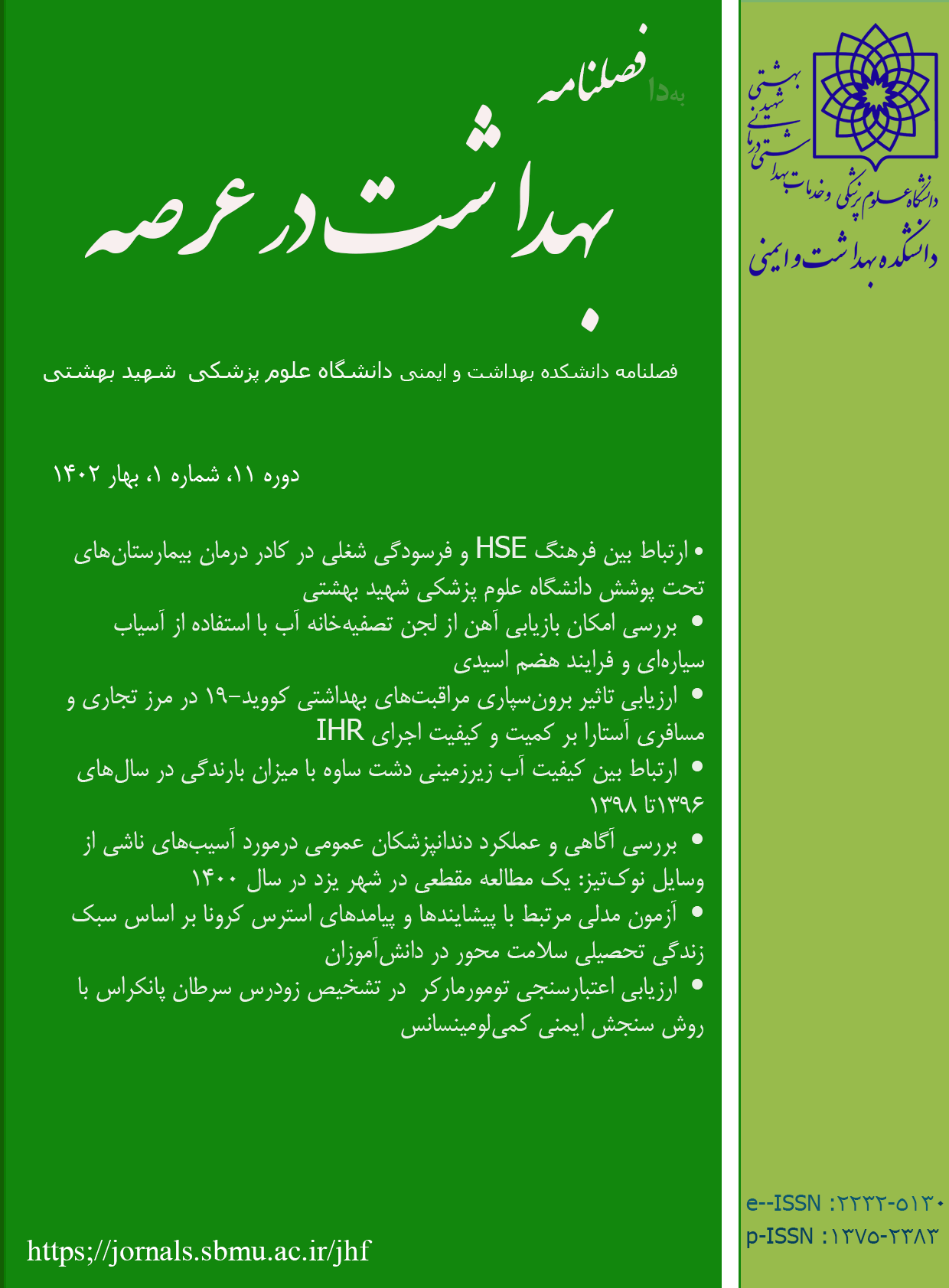شناسایی مولفه های حائز اهمیت حوادث شغلی و ارائه مدل بومی ثبت و گزارشدهی حوادث شغلی
فصلنامه علمی پژوهشی بهداشت در عرصه,
دوره 7 شماره 1,
20 اسفند 2019
https://doi.org/10.22037/jhf.v7i1.23183
چکیده
زمینه و اهداف: ثبت تعیین مولفههای حائز اهمیت حوادث شغلی و ثبتِ دقیق و صحیح آنها، امکان تحلیل حوادث شغلی در مقیاس خرد و کلان را فراهم مینماید. این تحلیلها در سیاست گذاری و برنامه ریزی پیشگیری از حوادث نقش کلیدی را ایفا میکنند. مطالعه حاضر با هدف شناسایی پارامترهای حائز اهمیت در ثبت حوادث شغلی و ارائه مدل بومی گزارش آن به انجام رسید.
مواد و روشها: در این مطالعه توصیفی- تحلیلی، 9 مدل گزارش حادثه مربوط به سازمانهای معتبر در این حوزه انتخاب و با آنالیز فراتحلیلی وجوه تمایز و تشابه آنها تعیین گردید. سپس با استفاده از تکنیک دلفی، مولفههای بومی حائز اهمیت در گزارشدهی حوادث تعیین و توسط سه معیار (کاربردی بودن)، (مرتبط بودن) و(ضروری بودن) اعتبار سنجی شدند. تمامی مراحل مطالعه حاضر طبق موازین اخلاقی اجرا گردید.
یافتهها: تعداد 42 مولفه برای ثبت و گزارش حوادث شغلی حاصل گردید و بر اساس آنها مدل نهایی برای ثبت و گزارش حادثه شغلی در پنج حیطه ارائه شد. این حیطهها عبارتند از: مولفههای حادثه دیده، مولفههای حادثه ایجاد شده، مولفههای علل حادثه، مولفه پیامد حادثه، مولفههای زمانی.
نتیجهگیری: ثبت حادثه، حادثه شغلی، مولفه های گزارشدهی حادثه
- ثبت حادثه؛ حادثه شغلی؛ مولفه های گزارش دهی حادثه
ارجاع به مقاله
مراجع
- Ehnes H, Niu S. Improvement of National Reporting, Data Collection, and Analysis of Occupational Accidents and Diseases. ٰ Geneva: International Labour Organization; 2012.
- Vincoli JW. Basic guide to system safety. New Jersey: John Wiley & Sons, Inc.; 2006.
- A. Safety management systems. Vuorimiehentie, Finland: VTT Publications; 2000.
- Jacinto C, Aspinwall E. A survey on occupational accidents’ reporting and registration systems in the European Union. Safety Science 2004; 42(10):933-60.
- Medzinárodná Organizácia Práce. Recording and notification of occupational accidents and diseases: An ILO Code of practice. Geneva: International Labour Office; 1996.
- Fyffe L, Krahn S, Clarke J, Kosson D, Hutton J. A preliminary analysis of Key Issues in chemical industry accident reports. Safety Science 2016; 82:368-73.
- Kletz T. Accident investigation-missed opportunities. Process Safety and Environmental Protection 2002; 80(1):3-8.
- Pérezgonzález J, McDonald N, Smith E. A review of the occurrence reporting system proposed by EASA Part-145. Safety Science 2005; 43(8):559-70.
- Sanne JM. Incident reporting or storytelling? Competing schemes in a safety-critical and hazardous work setting. Safety Science 2008; 46(8):1205-22.
- Health and Safety Executive. The Reporting of Injuries, Diseases and Dangerous Occurrences Regulations 2013. UK: Health and Safety Executive; 2013 [cited 2019 Jul 9]. Available from: https://notifications.hse.gov.uk/riddorforms/Injury.
- ILO, Improvement of national reporting, data collection and analysis of occupational accidents and diseases. Genova: International Labour Office; 2012.
- SAIPA. Occupational Accident Report in Iran. Tehran: SAIPA Group; 2012 (In Persian).
- Social Security Organization. Report work-related accidents. Tehran: Social Security Organization [cited 2019 Jul 9]. Available from: https://www.tamin.ir/file/file/121349
- Standards Association of Australia. Australian Standard® Worksafe Australia National Standard: Workplace injury and disease recording standard. North Sydney: Standards Association of Australia; 1990. Report NO. NS 002-1990.
- Workers Compensation Board. Worker’s Report. Canada: Worker compensation board of PEI; 2018.
- OSHA. Injury and Illness Incident Report. US Occupational Safety and Health Administration; 2004. [cited 2019 Jul 9]. Available from: http://www.osha.gov/recordkeeping/RKforms.html
- Webb G, Redman S, Wilkinson C, Sanson-Fisher R. Filtering effects in reporting work injuries. Accident Analysis & Prevention 1989; 21(2):115-23.
- Probst TM, Barbaranelli C, Petitta L. The relationship between job insecurity and accident under-reporting: A test in two countries. Work & Stress 2013; 27(4):383-402.
- U.S. Department of Labor. Bureau of Labor Statistics. Employer-Reported Workplace Injuries and Illnesses in 2017 [cited 2019 Jul 9]. Available from: https://www.bls.gov/news.release/pdf/osh.pdf
- U.S. Department of Labor, Bureau of Labor Statistics. National census of fatal occupational injuries in 2016. [cited 2019 Jul 9]. Available from: https://www.bls.gov/news.release/pdf/cfoi.pdf
- Sohrabi MS, Mahdavi N, Kalatpour O. Suggestion a Template for Accident Reporting Form. International Journal of Occupational Hygiene 2017; 9(4):215-22.
- Randall SB, Pories WJ, Pearson A, Drake DJ. Expanded occupational safety and health administration 300 log as metric for bariatric patient-handling staff injuries. Surgery for Obesity and Related Diseases 2009; 5(4):463-68.
- Rowe G, Wright G. The Delphi technique as a forecasting tool: Issues and analysis. International Journal of Forecasting 1999; 15(4):353-75.
- Oranga H, Nordberg E. The Delphi panel method for generating health information. Health Policy and Planning 1993; 8(4):405-12.
- Chu H-C, Hwang G-J. A Delphi-based approach to developing expert systems with the cooperation of multiple experts. Expert Systems with Applications 2008; 34(4):2826-40.
- Okoli C, Pawlowski SD. The Delphi method as a research tool: an example, design considerations and applications. Information & Management 2004; 42(1):15-29.
- McKenna HP. The Delphi technique: a worthwhile research approach for nursing? Journal of Advanced Nursing 1994; 19(6):1221-25.
- Körvers P, Sonnemans P. Accidents: A discrepancy between indicators and facts! Safety Science 2008; 46(7):1067-77.
- Kletz T. Learning from accidents. 3rd ed. London: Routledge; 2007.
- March L, Smith EU, Hoy DG, Cross MJ, Sanchez-Riera L, Blyth F, et al. Burden of disability due to musculoskeletal (MSK) disorders. Best practice & research Clinical rheumatology 2014; 28(3):353-66.
- چکیده مشاهده شده: 237 بار
- PDF دانلود شده: 279 بار
